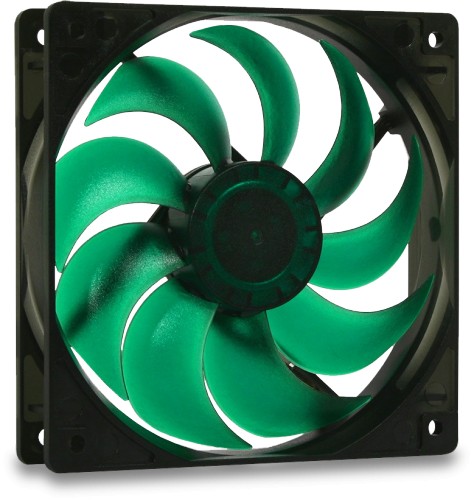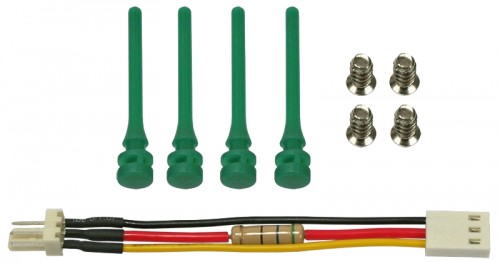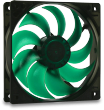Deep Silence 120mm Ultra-Quiet PC Fan, 1300 RPM Discontinued | |
| More variations available Show | |
Nanoxia Deep Silence 120mm Ultra-Quiet PC Fan, 1300 RPM
This 120mm fan from Nanoxia is the same fan found in their excellent Deep Silence cases and therefore recommended if you plan to add more fans to the DS cases.
Features
- Modern impeller design
- Rifle bearing
- 7V adapter cable supplied
- Optimised for Deep Silence cases
- 60.1 CFM, 14.2 dBA at 1300 RPM
Deep Silence fan series
The Nanoxia Deep Silence fan series have been optimised for very low noise operation. The fan frame and the impeller were developed in the wind tunnel allowing them to be optimised in many tests.
Modern impeller design
The impeller design of the Deep Silence Nanoxia fan has been perfected over many years of development. It allows the best possible compromise of efficient air flow rate and the lowest possible noise level.
Rifle Bearing
The Rifle bearing of the Deep Silence fans meets the latest standards and is of the highest quality. The high-quality bearing results in a particularly high life expectancy of at least 80,000 hours, and a very quiet cooling fan operation - especially at low speeds - is guaranteed.
7-Volt Adaptor cable included
Unless a fan controller is available, the power and speed of the Deep Silence fans can be customised according to your individual requirements, using the included 7-volt adaptor cable.
Optimal upgrade for Deep Silence cases
Please note that the 120 mm and 140 mm models of the Deep Silence Nanoxia fan series are used in all Deep Silence cases. If you intend to add more fans to your Deep Silence case, it is highly recommended that you choose these fans since they perfectly harmonise with the included fans to provide optimum controllability of your system.
The 120 mm models of the Deep Silence fan series are supplied with a 7 volt adapter cable. At 12 volts the fan rotates at 1300 revolutions per minute. The Deep Silence 120 mm generates an air flow of 60.1 CFM at a noise level of 14.2 dB(A). Using the 7 volt cable reduces the speed to approx. 900 rpm, which generates and air flow of 26,5 CFM at 8.6 dB(A).
| Specifications | DS 120mm Fan |
|---|---|
| Size | 120 x 120 x 25 mm |
| Rotation Speed (12 V) | 1300 RPM (± 10%) |
| Rotation Speed (7 V) | 900 RPM (± 10%) |
| Voltage Range | 5 - 12 V |
| Rated Current | 0.16 A |
| Rated Power | 1.92 W |
| Airflow (12 V) | 60.1 CFM |
| Airflow (7 V) | 26.5 CFM |
| Acoustical Noise (12 V) | 14.2 dB(A) |
| Acoustical Noise (7 V) | 8.6 dB(A) |
| Static Pressure (12 V) | 1327 mm H2O |
| Static Pressure (7 V) | 0.81 mm H2O |
| Cable Length | 44 cm |
| Connector | 3-Pin (incl. 7 V Adaptor) |
| Durability | 80,000 hours |
| Warranty | 24 months |
| EAN barcode | 4260285292705 |
| Specifications | DS 120mm Fan |
|---|---|
| Size | 120 x 120 x 25 mm |
| Rotation Speed (12 V) | 1300 RPM (± 10%) |
| Rotation Speed (7 V) | 900 RPM (± 10%) |
| Voltage Range | 5 - 12 V |
| Rated Current | 0.16 A |
| Rated Power | 1.92 W |
| Airflow (12 V) | 60.1 CFM |
| Airflow (7 V) | 26.5 CFM |
| Acoustical Noise (12 V) | 14.2 dB(A) |
| Acoustical Noise (7 V) | 8.6 dB(A) |
| Static Pressure (12 V) | 1327 mm H2O |
| Static Pressure (7 V) | 0.81 mm H2O |
| Cable Length | 44 cm |
| Connector | 3-Pin (incl. 7 V Adaptor) |
| Durability | 80,000 hours |
| Warranty | 24 months |
| EAN barcode | 4260285292705 |
Customer Reviews
A great purchase from an excellent company
I have been a customer of Quiet PC for several years and have bought several PC cases and various components, fans etc., from them. I have always had good and helpful service from them in spite of the fact that I live in Spain. So when I decided to get a quieter and less power-demanding case for my best PC I naturally turned to Quiet PC again. There, I settled on a Nanoxia Deep Silence 1 case. It is very reasonably priced and is also very well constructed and designed for best ventilation and ease of use. As I was in the frame of mind for a major transition to the speed and stability of SSDs I also ordered two Samsung 850 Pro 512 GB drives, an additional Nanoxia Deep Silence 120mm Ultra-Quiet fan for the top of the case’s ventilation ‘chimney’ (as it can get very hot in Spain) and a Scythe Kaze Master Fan Controller – because I like to be able to see the speed and running temperature of my case fans. The Deep Silence 1 comes with a built-in two zone fan controller for 4 fans but has no visual display. It has been a few years since I built my last PC so as soon as I started to load my existing Asus motherboard and its RAM and Intel CPU I realised that there were more advanced items out there now, so I upgraded the entire innards and now have a really fast machine that makes virtually no noise at all. As always, Quiet PC delivered the parts right on time and I now have the quietest PC I have ever had. It runs so quietly that the only time I can actually hear it at all is when the CPU is chewing on some data. Other than that I don’t even notice it under my desk. It was a great purchase from an excellent company. This case is very smart, well designed to maximise ventilation and space, and, as always, Quiet PC delivered everything on time and with excellent service.
Fantastic
I bought two of these to use as intakes for the front of my PC. They’re great quality and were easy to install. I have a ‘silent’ case with noise absorbing foam which traps heat as well so needed better cooling.
These fans have brought my idle and load temps down considerably, I would quote but I can’t reliably say what they were before. GPU idles at 26C and after hours of gaming it has maxed at 68/69C (with single 23” 1680x1050 monitor). Temperatures drop rapidly after finishing gaming. CPU idled around 36/37C before and now idles at 29/30C. They can be controlled fairly well by software.
They only minor con is they’re slightly louder than anticipated but this is easily managed by slowing them when idle and they’re not loud enough to be noticed when gaming.
FAQ
How do I measure fan size?
The size of fan you need will generally be determined by the size of the fan fitting position in your PC case. The sizes of all the fans on our website are shown as measured along any one of the fan’s four sides, NOT the distance between the fan’s screw holes! Our most popular fan size is 120mm, followed by 80mm. This isn’t really dictated by customer preference, but more by recent designs of PC cases.
As for the thickness (depth) of the fan, generally 25mm (1 inch) is by far the most common depth, although smaller fans can have shallower depths such as 15mm or even 10mm. All our fans are 25mm thick unless otherwise stated. If you have any questions about which fan you should order, please don’t hesitate to get in touch.
If you know the distance between the fan mounting screw holes but don’t know what fan size to order, please see the following table. Note that the mounting hole measurements shown below are taken horizontally or vertically between the holes and not diagonally.
Screw hole spacings and fan sizes
Space Between Screw Holes Fan Size 32mm 40mm 40mm 50mm 50mm 60mm 60mm 70mm 72mm 80mm 83mm 92mm 105mm 120mm I received a small cable (resistor) with my fan; what is it for?
The resistor cable (also called Ultra Low Noise or ULN cable) is designed to allow the fan to run slightly slower for even quieter operation. The benefit in lower running noise is significant. Although the airflow will be reduced slightly, this usually has minimal effect on PC temperature. We would generally recommend using the ULN resistor cable for best results in almost all circumstances.
How can I tell which way the air blows through the fan?
Hold the fan so that the round fan sticker is facing you. You are looking at the rear of the fan. When you plug the fan in, the air will be blowing towards you. If you want a fan to act as an air intake, then the fan sticker will be facing the inside of the case. Some fans also have two small arrows moulded into their plastic housing - one arrow shows the direction of airflow, and the other (at 90°) shows the direction of blade rotation.
Is it possible to use a 4-pin PWM fan or CPU cooler with a motherboard which has only 3-pin fan headers on it?
Electrically, there is no problem doing this - the fourth pin on the fan cable is used purely for PWM control and is not needed in order for the fan to run. So you can plug the 4-pin fan connector onto the 3-pin motherboard fan header, leaving the fourth pin not connected to anything. The fan will potentially run at full speed, so if you would like to reduce the speed of the fan you will need to adjust the fan speed setting in your BIOS or use fan control software such as SpeedFan in Windows.
The only other problem to consider is that occasionally, components immediately adjacent to the motherboard fan header can get in the way of the larger 4-pin fan connector, physically preventing connection. This problem also occurs if you try to use an in-line fan speed controller such as the one made by Gelid.
Another avenue to explore is the possibility of using a bay-mounted fan controller. Several models are available now which provide 4-pin fan headers, so this is an easy way to use 4-pin PWM fans in a PC system which has only 3-pin fan headers on its motherboards. When using this method, you may find it necessary to disable any fan warning settings in your motherboard BIOS, since the motherboard may incorrectly believe that its CPU fan has failed when the fan is connected to a fan controller rather than directly to the motherboard itself.
Top Quiet Fans
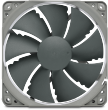
Noctua NF-P12 REDUX PWM 12V 1700RPM 120mm Quiet Case Fan

Noctua NF-F12 iPPC PWM 12V 3000RPM 120mm High Performance Fan

Noctua NF-A12x25 PWM chromax.black.swap 12V 2000RPM 120mm Fan

Noctua NF-R8 REDUX 12V 1800RPM 80mm Quiet Case Fan
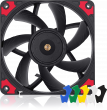
Noctua NF-A12x15 PWM chromax.black.swap 12V 1850RPM 120x15mm Fan

Noctua NF-A12x25 PWM 12V 2000RPM 120mm Ultimate Quality Quiet Fan
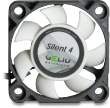
Gelid Silent 4, 40mm Quiet Case Fan

Noctua NF-R8 REDUX PWM 12V 1800RPM 80mm Quiet Case Fan

Noctua NF-F12 iPPC PWM 12V 2000RPM 120mm High Performance Fan
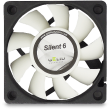
Gelid Silent 6, 60mm Quiet Case Fan

